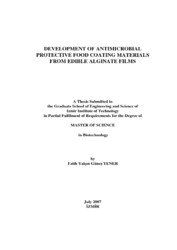Please use this identifier to cite or link to this item:
https://hdl.handle.net/11147/3856Full metadata record
| DC Field | Value | Language |
|---|---|---|
| dc.contributor.advisor | Korel, Figen | - |
| dc.contributor.author | Yener, Fatih Yalçın Güneş | - |
| dc.date.accessioned | 2014-07-22T13:52:31Z | - |
| dc.date.available | 2014-07-22T13:52:31Z | - |
| dc.date.issued | 2007 | - |
| dc.identifier.uri | http://hdl.handle.net/11147/3856 | - |
| dc.description | Thesis (Master)--Izmir Institute of Technology, Biotechnology, Izmir, 2007 | en_US |
| dc.description | Includes bibliographical references (leaves: 92-98) | en_US |
| dc.description | Text in English; Abstract: Turkish and English | en_US |
| dc.description | xiv, 101 leaves | en_US |
| dc.description.abstract | Consumer interests in high quality, healthy, convenient and safe food continue to increase, presenting food processors with new challenges to which functional edible coating and film concepts offer potential solutions. The interest in the research of edible film which has many advantages and applications has increased during last decade.There is a particular interest in the use of antimicrobial biopreservatives in edible films and to increase food safety without application of chemical preservatives. In this study,we have developed antimicrobial or protective edible films by incorporation of antimicrobial enzyme lactoperoxidase or protective cultures (Lactobacillus delbrueckii subsp. lactis and Lactobacillus plantarum) into alginate films, respectively. The main objective of this research was to increase food safety by using lactoperoxidase or lactic acid bacteria incorporated into alginate films. The results obtained in the study showed that in reaction mixtures, the lactoperoxidase system has antimicrobial activity against E. coli, L. innocua, and P. fluorescens. The developed lactoperoxidase incorporated antimicrobial films also reduced the total microbial load of a selected seafood during cold storage. The lactic acid bacteria, used in edible films for the first time, also successfully incorporated into alginate films. The bacteria showed sufficient stability in alginate films and at surface of red meat during cold storage. The results of this study clearly showed the good potential of using lactoperoxidase and lactic acid bacteria incorporated alginate films in food packaging. The developed films can be used in antimicrobial packaging or protective packaging. However, further studies are needed to show the beneficial effects of developed films on different food systems. | en_US |
| dc.language.iso | en | en_US |
| dc.publisher | Izmir Institute of Technology | en_US |
| dc.rights | info:eu-repo/semantics/openAccess | en_US |
| dc.subject.lcc | TP451.E3 Y45 2007 | en |
| dc.subject.lcsh | Edible coatings | en |
| dc.subject.lcsh | Food--Packaging | en |
| dc.subject.lcsh | Food preservatives | en |
| dc.subject.lcsh | Anti-infective agents | en |
| dc.title | Development of Antimicrobial Protective Food Coating Materials From Edible Alginate Films | en_US |
| dc.type | Master Thesis | en_US |
| dc.institutionauthor | Yener, Fatih Yalçın Güneş | - |
| dc.department | Thesis (Master)--İzmir Institute of Technology, Bioengineering | en_US |
| dc.relation.publicationcategory | Tez | en_US |
| dc.identifier.wosquality | N/A | - |
| dc.identifier.scopusquality | N/A | - |
| item.openairecristype | http://purl.org/coar/resource_type/c_18cf | - |
| item.cerifentitytype | Publications | - |
| item.fulltext | With Fulltext | - |
| item.languageiso639-1 | en | - |
| item.grantfulltext | open | - |
| item.openairetype | Master Thesis | - |
| Appears in Collections: | Master Degree / Yüksek Lisans Tezleri | |
Files in This Item:
| File | Description | Size | Format | |
|---|---|---|---|---|
| T000658.pdf | MasterThesis | 820.59 kB | Adobe PDF |  View/Open |
CORE Recommender
Page view(s)
170
checked on Apr 28, 2025
Download(s)
62
checked on Apr 28, 2025
Google ScholarTM
Check
Items in GCRIS Repository are protected by copyright, with all rights reserved, unless otherwise indicated.